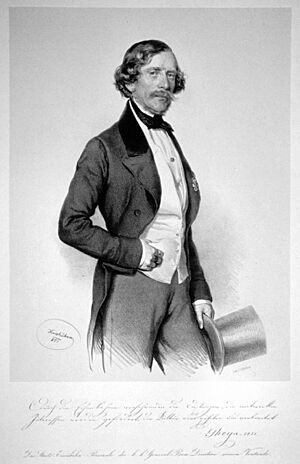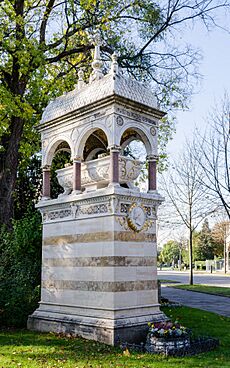Karl Ritter von Ghega facts for kids
Quick facts for kids
Carl Ritter von Ghega
|
|
|---|---|

Carl Ritter von Ghega, drawn by Joseph Kriehuber, 1851
|
|
| Born |
Carlo Ghega
10 January 1802 |
| Died | 14 March 1860 (aged 58) |
| Resting place | Zentralfriedhof, Vienna |
| Nationality | Austrian |
| Occupation | Engineer |
| Known for | designing and engineering the Semmering Railway |
Carl Ritter von Ghega (born January 10, 1802 – died March 14, 1860) was a famous engineer. He was from Austria and designed the amazing Semmering Railway. This railway connected the towns of Gloggnitz and Mürzzuschlag. During his life, he was one of the most important railway engineers and architects in Austria.
Contents
Early Life and Education
Carl Ghega was born in Venice, which is now part of Italy. His family was of Albanian background. His father, Anton Ghega, worked as an officer in the Austrian navy.
Carl was a very smart student. He studied in Padua, a city in Italy. By the time he was just 18 years old, he had already earned a degree in mathematics.
Starting His Engineering Career
Carl Ghega began his career working on roads and water systems in Venice. He helped build an important road over the mountains from Cortina d'Ampezzo to Toblach.
Later, he became very interested in railways. Railways were a new and exciting way to travel across Europe. From 1836 to 1840, he supervised the building of a railway line. This line went from Brno to Břeclav and was called the Emperor Ferdinand North Railway.
To learn more, Carl traveled to England and other European countries. He studied their railway systems in 1836 and 1837. In 1842, he even went on a study trip to North America. He was put in charge of planning all future state railways in Austria.
Designing the Semmering Railway
After his travels, Carl von Ghega started planning a railway line to the south. This line would go from Mürzzuschlag to Graz and Trieste. A big challenge was crossing the Semmering Pass, a very steep mountain area. Many people thought it was impossible to build a railway there.
But Carl von Ghega believed it could be done. In 1844, he presented a plan for crossing the Semmering. His plan included special locomotives that could climb steep hills without extra gear wheels. He worked hard to make sure these powerful locomotives were built.
Construction of the famous Semmeringbahn (Semmering Railway) began in 1848. It was a huge project, but it was completed in 1854. This railway was an amazing engineering achievement for its time.
Later Projects and Legacy
In 1856, Carl von Ghega also helped build the Borovnica viaduct. This was a very impressive railway bridge. It was part of the Austrian Southern Railway that connected Vienna to Trieste.
Carl von Ghega was then assigned to build a railway in Transylvania. However, he could not finish this project. He sadly passed away in Vienna in 1860 due to tuberculosis.
Carl Ritter von Ghega is remembered as a visionary engineer. His work, especially the Semmering Railway, changed how people traveled and transported goods across mountains.
See also
- In Spanish: Karl Ghega para niños


